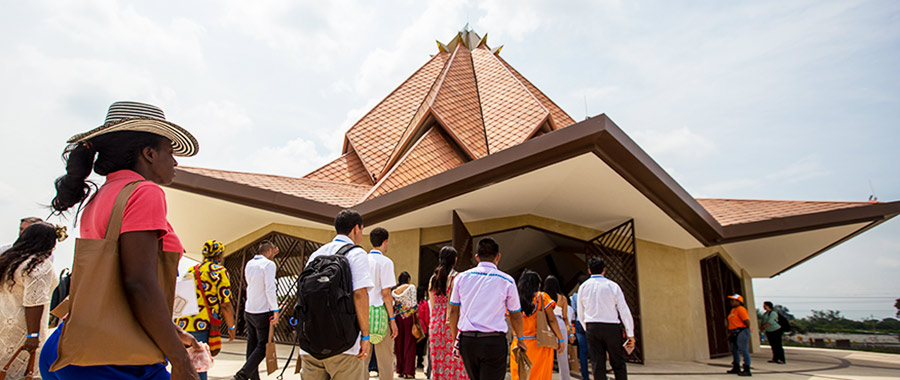The recent dedication of the Bahá’í Temple in Colombia stands as a luminous testament to spiritual unity and architectural brilliance. This event, imbued with joy and reverence, signifies not merely the completion of a building, but the establishment of a sanctuary dedicated to the principles of love, peace, and harmony among humanity. This glorious edifice, nestled within Colombia’s verdant landscape, is a beacon that draws forth a multitude of souls seeking solace and connection.
At once a symbol and a sanctuary, the Bahá’í Temple invites contemplation on the significance of its existence. Much like a flower blossoming in a riot of colors, the temple encapsulates the essence of Bahá’í teachings—a vibrant manifestation of humanity’s quest for unity. This creation stands as a metaphorical bridge, linking the heart’s yearning for spiritual fulfillment with the earnest endeavor for social cohesion.
The gathering for the temple’s dedication was marked by an array of joyous ceremonies which blended rich cultural traditions with the elevated tenets of the Bahá’í faith. Attendees from diverse backgrounds came together, united in purpose and spirit, to celebrate this momentous occasion. The temple’s design, with its radiant white exterior and interwoven arches, reflects the Bahá’í belief in the oneness of mankind. Each facet of its structure serves as an invitation for individuals to transcend their differences, meeting not only in worship but also in the shared pursuit of personal and collective growth.
Within this sacred space, the principles taught by Bahá’u’lláh resonate palpably. The temple serves as a microcosm of what humanity can achieve when it embraces unity over division. The very architecture, soaring toward the heavens, mirrors the aspirations of all who enter. As one stands within its hallowed walls, there is a palpable sense of serenity, akin to the gentle rustle of leaves in a tranquil forest. This environment nurtures contemplation and introspection, allowing for profound spiritual experiences that linger long after visitors depart.
The dedication ceremony itself was imbued with layers of significance, much like the temple’s multi-faceted design. Speeches extolling the virtues of unity and service intertwined with musical performances that echoed the universal language of love and hope. Comprising melodious harmonies and lyrics that spoke to the shared human experience, these performances became vectors of inspiration, reinforcing the temple’s role as a cultural anchoring point for future generations.
In addition to its physical presence, the temple’s dedication highlights a broader narrative of the Bahá’í community’s commitment to service. This commitment extends far beyond the confines of the temple itself, reaching into the surrounding communities. The Bahá’í teachings advocate for the empowerment of individuals to contribute meaningfully to society, fostering a spirit of collaboration and collective celebration. Various educational and social programs emanate from this monument, designed to empower individuals and nurture a culture of service.
One of the truly unique aspects of the Bahá’í Temple in Colombia is its open-door policy. Unlike many places of worship that may restrict access, this temple welcomes people of all faiths and backgrounds. It is, ideally, a refuge where inquiries and exploration of spiritual truth can flourish without the weight of dogma weighing down on seekers. This inclusivity embodies the Bahá’í principle that the light of divine knowledge belongs to humanity collectively, not to a select few.
The temple’s setting amidst the verdant Colombian hills further enhances its symbolic significance. Nature plays a crucial role in Bahá’í teachings, representing the divine handiwork of God and inviting reflection on the interconnectedness of all creation. The harmonious interaction between the temple and its natural surroundings symbolizes the Bahá’í belief in the synthesis of science and religion, serving as a reminder that spirituality can exist in concert with a profound appreciation for the environment.
Moreover, the significance of the temple extends to its role as a center for community gathering and interfaith dialogue. Here, individuals are called upon to engage in the age-old quest for understanding and cooperation. It stands as a people’s forum, where discussions can burgeon into collaborative initiatives aimed at addressing pressing social issues. The temple functions as a catalyst for dialogue that transcends barriers, uniting people in their shared desire for peace and justice.
Ultimately, the dedication of the Bahá’í Temple in Colombia is a luminous chapter in the ongoing narrative of humanity’s spiritual evolution. It invites each visitor to reflect on the core Bahá’í tenet of the oneness of mankind, grounding its foundation in love and earnest endeavor. The temple resonates with a call to action, urging individuals to honor the precious bonds that connect us all, regardless of our diverse paths of faith and belief. Through its luminous architecture, profound symbolism, and commitment to service, the temple stands not only as a physical structure but also as a compelling metaphor for a new dawn of unity and understanding for humankind.
